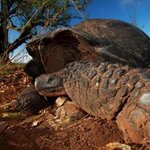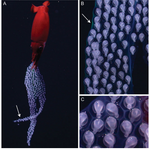Ecology & Zoology

The Galapagos giant tortoise, the largest living species of tortoise (and in the top 10 reptiles), likes to move around.
We know this because scientists with the Max Planck Institute for Ornithology and the Charles Darwin Foundation have used GPS technology and 3-D acceleration measurements to find out that the dominant male tortoise will wander up to 10 kilometers into the highlands of the island - but only the fully grown animals migrate, the young tortoises stay in the lowlands.
Why? And why don't they rest during the dry season? It's a Chelonoidis nigra mystery of…

How some dahlias, white, yellow, red or purple, get their color is well known, but the molecular mechanism behind the black dahlia has been a mystery. A new study shows that the distinctive black-red coloring is based on an increased accumulation of anthocyanins as a result of drastically reduced concentrations of flavones.
Dahlia variabilis hort. is a popular garden flower. Continuous dahlia breeding worldwide has led to the availability of a huge number of cultivars, 20,000 varieties, many of them showing red hues. However, black hues of dahlia flowers occur rarely, in comparison.…

Studying the genetic variability of endangered species will be necessary for species conservation and monitoring but endangered species are difficult to observe and sample and typically have very limited genetic diversity.
A research team has taken advantage of DNA sequencing methodology developed by Floragenex to identify the genetic markers for the Bornean elephant, an endangered species, using blood from very few animals. The results showed that Bornean elephants have very low genetic variability that can impact on their survival to a threatened habitat, but that variable genetic…

BOSTON, MA—“The trees are certainly shorter out here,” said Luke.
The East Coaster in me bristled instantly. “Well, sure, nothing’s going to measure up to a Redwood,” I said, “but these guys along the road are hardly the best that Massachusetts has to offer.”
As Luke mused out loud over the tall trees that could be found in his home state of Oregon, I thought about what the forests of the Northeastern United States would have looked like centuries before the highway we now cruised was constructed.
I grew up in the heartland of the deciduous tree, embedded within the wedge of our country whose…

The fossilized fangs of saber-toothed cats, a leopard-sized Promegantereon ogygia and a much larger, lion-sized Machairodus aphanistus, hold clues to how large, extinct mammals once shared space and food with other large predators 9 million years ago.Paleontologists have analyzed the tooth enamel of two species of saber-toothed cats and a bear dog unearthed in geological pits near Madrid. Bear dogs, also extinct, had dog-like teeth and a bear-like body and gait.
Promegantereon ogygia and Machairodus aphanistus lived together in a woodland area. They likely hunted the same prey, horses…

Squid typically die after spawning. Their orphaned eggs are left alone in the cold brine to develop and hatch, never knowing a mother's tender caress.
But as in all of biology, there are exceptions.
It's strangely appropriate that the second of these exceptions has entered, stage left, just as I am preparing to exit, stage right, in order to engage in the intensive parental care typical of humans. I'll be spawning within the next few weeks, and taking a hiatus from the blogosphere to focus on my in-home developmental biology experiment.
So let me leave you with the remarkable image of a…

1.8 million years ago, giant German hippopotamuses wallowed on the banks of the Elbe.
Hippos were all over Europe then, along with other megafauna like woolly mammoths and giant cave bears. What went wrong? Palaeontologists blame global cooling during the Pleistocene Era, which may have forced Europe’s hippos to shrink to pygmy sizes before finally driving them to warmer climes.
Hippos were a constant feature of European wildlife for about 1.4 million years, all through the climatically turbulent time of the Pleistocene era, which witnessed 17 glacial events. The experience of…

In the African savannah can reach 149° Fahrenheit in the middle of the day, which leads to burning sand and an obvious problem for anything that lives there, including small insects that spend their lives on the surface of the sand. Some insects seek protection in the shade or climb up blades of grass to escape the worst of the heat.
But South African dung beetles have come up with a unique strategy to escape the heat of the sun; they climb on top of their rolled-up meal, which happens to be a ball of dung. These dung balls are a kind of air conditioning unit because the ball is made…

Dogs are susceptible to contagious yawning just like people, says an article in Animal Cognition, but only after they get older. Dogs, like humans, show a gradual development of susceptibility to contagious yawning and the new paper says dogs catch yawns from humans. But Only dogs above seven months of age catch these human yawns - younger dogs are immune to the contagion.
Contagious yawning has been researched in humans, adult chimpanzees, baboons and dogs, some speculate it can be used as a measure of empathy. Empathy, mimicking the emotional responses of others, is difficult to measure…

The best reasons to allow hunting in animal-heavy states are that they get hit by cars a lot and they starve. When it comes to cars, some areas are going to be a lot more dangerous than others and it is not a question of how many animals are there but simply where the road is. They have done things their way for 6,000 years and don't want to change, regardless of what automobiles might like.
But the animals will go over. Case in point: The Wildlife Conservation Society (WCS) has announced the successful use of newly constructed overpasses that provide safe passage for thousands of migrating…